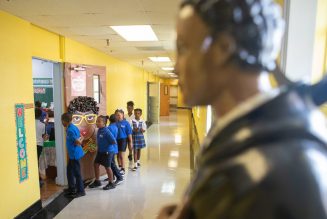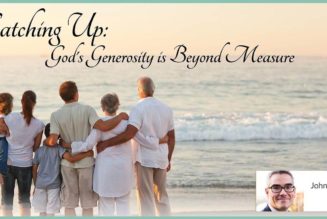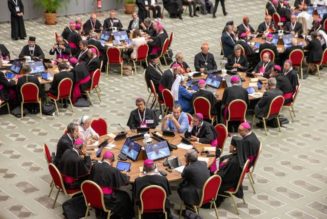Editor’s Note: The Atlantic is making vital coverage of the coronavirus available to all readers. Find the collection here.
The new coronavirus has brought American life to a near standstill, closing businesses, canceling large gatherings, and keeping people at home. All of those people must surely be wondering: When will things return to normal?
The answer is simple, if not exactly satisfying: when enough of the population—possibly 60 or 80 percent of people—is resistant to COVID-19 to stifle the disease’s spread from person to person. That is the end goal, although no one knows exactly how long it will take to get there.
There are two realistic paths to achieving this “population-level immunity.” One is the development of a vaccine. The other is for the disease to work its way through the population, surely killing many, but also leaving many others—those who contract the disease and then recover—immune. “They’re just Teflon at that point,” meaning they can’t get infected again and they won’t pass on the disease, explains Andrew Noymer, a public-health professor at the University of California at Irvine. Once enough people reach Teflon status—though we don’t yet know if recovering from the disease confers any immunity at all, let alone lifelong immunity—normalcy will be restored.
Unfortunately, both of these paths could be a year or two long, but degrees of normalcy will likely be won back in the meantime: Come summer, Americans might get restaurants but no music festivals, offices but no crowded beaches, bars with spaced-out seating. Projecting when each facet of daily life will be restored would be easier if public-health authorities had an omniscient view of who is infected, who has recovered and become immune, and who is still susceptible—this is the information that would emerge from widespread testing, which the United States is terribly behind on deploying.
Read: The crisis could last 18 months. Be prepared.
As such, America is currently left with self-isolation, a blunt tactic that can slow the spread of the virus, potentially sparing the country’s hospitals from a catastrophic overload of patients, but that comes at the cost of freezing daily life. Epidemiologists I interviewed stressed that they have no idea when life will be unfrozen, but they walked me through a series of possible timelines on which Americans might be able to safely start leaving the house to make money or do fun things again. Below are those timelines, including some turning points to look out for in the coming weeks, months, and years.
No matter what, staying safe means staying home for a while yet, despite Donald Trump’s desire, expressed at a Fox News town hall on Tuesday, “to have the country opened up, and just raring to go, by Easter.” Moving back toward normalcy at this early stage could be disastrous. “Prematurely ending severe social distancing would be an incredible blunder that would have major human consequences,” Noymer told me. “What is ‘prematurely’? The truth is, we don’t know yet, exactly, but it’s longer than a fortnight. It could be eight to 12 weeks.”
I should note that the experts I spoke with think this timeline is highly unlikely. But America could be through with most of its social distancing in a month or two if the coronavirus turns out “to not be a serious pathogen, suddenly,” said William Hanage, an epidemiology professor at the Harvard T. H. Chan School of Public Health. “All of the people who are now infected, instead of behaving like the infected people we’ve seen [before], have very mild disease, and we realize that immunity is being generated.” This “false alarm” outcome would of course be fantastic, but also produce “a lot of head-scratching” among public-health experts, Hanage said.
Another path to a short-term resolution is much grimmer: Too-lax social distancing could produce what Noymer calls a “big, short, sharp shock” of infections sometime in the next few months, overwhelming the health-care system and killing enormous numbers of people. After such a catastrophe, it’s conceivable that lots of people infected with the virus would recover, bringing the broader population closer, if not all the way, to immunity.
Both of these eventualities would make it okay to go out again in a couple of months, but even if Americans are still mostly cooped up at home in late spring, public-health experts will have learned more about the virus by then. Perhaps most important, they should know how much strain this first wave of infections will have put on America’s hospitals, and thus how effective containment efforts have been. This information isn’t readily available now, Hanage explained, because people who get infected today generally won’t require intensive care until several weeks from now. Also in a month or two, public-health authorities and researchers will likely have a better sense of whether those who recover from an infection are immune to future infections, and if so, for how long. That information will come in handy for containment efforts.
Read: How the pandemic will end
In this timeline, Hanage speculated, “we learn some things about the virus that make us much more confident about being able to resume various activities. One of them might be that we actually have substantial immunity already, through mild infections” or even asymptomatic ones.
These are the sorts of things that could be learned from months of testing both people who have symptoms and people who don’t. Two types of tests matter here: one that detects the presence of the virus itself, and one that detects the antibodies that people develop when they’re immune to it.
With this new information, Hanage said, it might be possible to isolate contagious or more vulnerable people, while a large portion of the population returns to something resembling normal life. “You can have fewer tables to a restaurant, for instance, or a smaller number of people at a bar,” he said. Meanwhile, if some places have much higher incidences of the disease than others, people in some states and cities might leave home sooner or during different periods than people elsewhere in the country.
Michael Stoto, a professor of health-systems administration and population health at Georgetown University, told me that three variables dictate the spread of a disease: “how many people the average person encounters in a day when transmission could take place” (whether through face-to-face interaction or from touching the same surface), “the chance that the virus will be transmitted in each of those interactions,” and “the proportion of people that you encounter who are themselves infected.”
If more and better-targeted testing started to yield a fuller picture of the spread of the virus, Stoto said, public-health authorities might choose to focus on one variable more than another. For instance, if testing data indicated that reducing people’s number of encounters (the first variable) would be highly effective, maybe restaurants and small businesses would reopen, but large, crowded events would be canceled or remain postponed. “Some of the extreme things we’re doing now, we might be able to drop sooner rather than later,” he said.
And in three to four months, researchers might have identified a treatment for COVID-19—not a cure, but something that could quickly and reliably ease symptoms and prevent deaths. This wouldn’t eliminate the continued need for social distancing, since large-scale outbreaks would still be possible, but it could reduce the risk of overburdening the country’s hospitals if an outbreak arose.
To Hanage, this timeline is likelier than the false-alarm scenario, but “all of this is Who knows exactly?”
Read: The president is trapped
One big unresolved question about COVID-19 is whether, like the flu, its spread will slow substantially during the summer. Researchers have a few theories for why summer is a season unfriendly to the flu—it could be that higher temperatures and increased UV radiation are inhospitable to some viruses, and/or that most schools are out of session, depriving viruses of a crucial breeding ground. But whether either of those theories applies to the coronavirus is not yet known.
Noymer guesses that we’ll find out if COVID-19 is seasonal sometime in the next two to three months, and here is where Timeline Three splits in two: In one possible universe, the virus recedes in the summer. In the other, it doesn’t. In both, at least some of the social distancing measures now in place continue into the second half of the year.
In the first universe, Noymer said, summer will be a bit more fun than spring was, at least in the Northern Hemisphere. Outdoor activities in small groups would probably be fine. Maybe bars and restaurants would reopen. But large gatherings would likely be out: “No Lollapalooza, no Major League Baseball, no crowded beaches,” Noymer guesses.
Hanage thinks that sports leagues might resume in the summer but without crowds, and that TV shows might forgo studio audiences. Meanwhile, stores might cap the number of shoppers allowed in at once. “I really don’t think that large crowds are going to be a thing for quite some time,” he said. But the smaller-scale units of American life might be phased back in.
It might even be (relatively) safe to travel to see loved ones. “Once it’s everywhere, and you are as likely to get infected in your local convenience store as anywhere, travel restrictions make very little sense,” Hanage said. “That said, there would need to be some responsible measures to help people not get too crowded in the airports.”
The downside of this closer-to-normal summer is that a resurgence of the disease in six months or so is a strong possibility (though not guaranteed). This “fall wave” of infections might arrive in September or October, reintroducing the need for social distancing. That social distancing might be on par with what’s happening now, or it might be eased a bit: By then, many people could have developed immunity, and could theoretically go out without risking infection. And we’ll know more about the virus too. If we’ve learned by the fall that children don’t spread it, schools might even reopen.
Also, the country would hopefully be in a better position to absorb another wave of infections. The summer would be a good time to produce more ventilators, hospital beds, and the protective equipment that health-care workers wear to prevent infection. “If we get seasonality, saving our bacon in the short term … we need to use the summer lull to steel our response” in the fall, Noymer said. With the proper steeling, social distancing might be able to be scaled back further.
In the second possible universe, we don’t get a summer reprieve. The current oncoming spike in cases would, hopefully, subside as a result of isolation measures taken now, but the risk of a resurgence would remain high in the warmer months. If the number of cases isn’t falling significantly by early to mid-June, Noymer said, that’s how we’d probably know the virus isn’t seasonal.
At that point, social-distancing measures could be modified according to the situation. If another onslaught of infections appears to be approaching, Americans could be stuck where they are now. But if there’s good enough data indicating that hospitals shouldn’t be overwhelmed, social distancing could be scaled back.
Read: What could happen if the coronavirus closed schools for days, weeks, or even months
“Once the [current] wave is dealt with, then some things might relax—a little,” Hanage said. More out-of-the-house working and socializing might take place, but this would still be a world with rigorous hand-washing, well-smothered sneezing, and generous amounts of hand sanitizer (and suspicion of anyone who disregards these public-health norms). In all likelihood, people who can work remotely or order food via delivery would still do so instead of leaving the house.
The fall could introduce some chaos, regardless of the virus’s seasonality. “There’s the small matter of an election, which is a potentially huge superspreading event,” Hanage noted. (He also worries that social-media rumors of, say, people coughing near a certain polling place could cause turnout there to plummet.) And of course, the flu will return around the time of the election too, making it hard to tell, without a test, if any given person has COVID-19 or the flu—an ambiguity that isn’t as onerous now, during the tail end of flu season. The election and the flu are reminders that all of the things that happen under normal circumstances—including natural disasters (summer and fall are hurricane and wildfire season too, don’t forget)—won’t necessarily be put on hold during this highly abnormal time.
Amid everything I’ve described so far—the crowd-free baseball games, the bars and restaurants with spaced-out seating, and so on—researchers around the world will have been scrambling to develop a vaccine. Spring 2021 is about the earliest anyone expects one to be available. “Anything faster would be world-record, lightning speed,” Noymer said. If it’s a “rough draft and needs to be polished,” it would take longer, possibly another six months or a year after next spring.
Vaccines take so long to make because they are difficult to perfect. There are a series of methodical trials done to make sure they don’t harm healthy people, to make sure they generate the desired antibodies, and to make sure those antibodies actually defend against the disease. These aren’t overcautious bureaucratic safeguards; if researchers are making something that’s going to be pumped into the arms of hundreds of millions, probably billions, of people, they want to make sure it’s just right.
And if it’s just right, normal life will resume, but not immediately. “The logistics of vaccinating [nearly] 350 million people is no mean feat,” Stoto said. He also noted that, “assuming that it doesn’t all arrive in one big batch,” some sort of system would need to be in place for determining who gets the first doses: the people most vulnerable to the disease? Health-care workers?
It’s also possible that no one is able to develop a safe, effective vaccine. This would be a disappointment, but even then, America could be well on its way to population-level immunity, perhaps reaching a Teflon critical mass by the fall of 2021. And the journey from now to then would probably not mean being cooped up indoors continuously for more than a year. “If we can’t come out of our groundhog holes for more than 12 months,” it’s because the coronavirus is about as ferocious and noncompliant as it could possibly be, producing “some perfect storm of viral epidemic in which we can never relent,” Noymer said.
Even in a vaccine-less world, reaching population-level immunity means that future outbreaks of COVID-19 should be far less damaging than the one the U.S. is currently confronting. The virus might, however, remain threatening and continue to circulate, infecting people like the cold or flu does. This wouldn’t be ideal, but by then, life would be back to normal—though at the same time, completely changed.
We want to hear what you think about this article. Submit a letter to the editor or write to letters@theatlantic.com.










